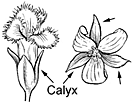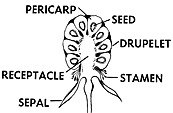Forest Sandalwood
Santalum freycinetianum
Mistletoe/Toadflax family (Santalaceae)
Native species ()
This species with its varieties will serve as an example of the red-flowered sandalwoods. Reported as a large tree to 82 ft (25 ) high and 3 ft (0.9 ) in trunk diameter in the natural forest, with slender drooping branches. Bark of small trunks gray, smoothish.

©2009 David Eickhoff
Flower clusters () and lateral, branched. Flowers 3–9 or more, nearly stalkless, about 1⁄4 inch (6 ) long yellowish to white, turning red in age, composed of narrow bell-shaped tube () with four- four short attached near base of tube and and with one-celled partly inferior, threadlike and mostly three-
() elliptical, 5⁄16–5⁄8 inch (8–15 ) long, with ring scar at purplish black with a bloom, within greenish and juicy.
Fairly common in dry forests of both Waianae and Koolau Ranges, Oahu. More common in the Waianae Range which is drier, especially at 800–2000 ft (244–610 ).
Special areas
Aiea, Waimea Arboretum, Kamehameha School
Range
Oahu, Kauai, Lanai, and Maui
This species was greatly reduced as a forest tree during the early part of the last century because of the export of the fragrant wood. Its name commemorates Henri Louis Claude de Saulces de Freycinet (1779–1840), leader of a French world expedition in 1817–20. The generic name is derived from the Greek name for sandalwood.
Besides the typical variety on Oahu, two varieties formerly treated as species, are distinguished: Kauai sandalwood, Santalum freycinetianum var. pyrularium (Gray) Stemm., on Kauai, and Lanai sandalwood, S. freycinetianum var. lanaiense Rock, on Lanai and Maui, listed as endangered.
The two other species of sandalwood native to Hawaii are:
Hawaii sandalwood, Santalum paniculatum Hook. & Arn., grows on the Island of Hawaii in dry forests and lava fields at 1500–6500 ft (457–1981 ), sometimes to 8000 ft (2438 ). It has greenish flowers and may be seen at Hawaii Volcanoes National Park near Volcano House.
Haleakala sandalwood, Santalum haleakalae Hillebr., grows on Maui at 6000–8800 ft (1829–2682 ). Large clusters of flowers that become deep red as they age make this the most beautiful species. It is easily seen near Hosmer Grove in Haleakala National Park.








